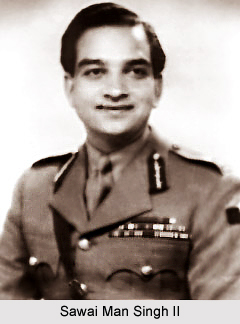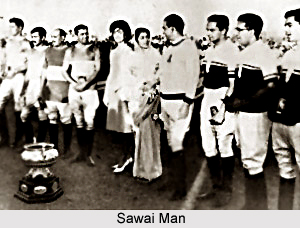 Sawai Man Singh II, popularly known as Mor Mukut Singh was the last ruling Maharaja of Jaipur belonging to Kachwaha clan of Rajputs. Born on August 21, 1911, Sawai Man Singh II ruled the princely state between 1922 and 1949 and eventually the state acceded unto the Dominion of India. Since then, Sawai Man Singh II held office as Rajpramukh of Rajasthan from 1949 to 1956. In later life, Sawai Man Singh II served as Ambassador of India to Spain. He was also known as a notable sportsman and eminent polo player.
Sawai Man Singh II, popularly known as Mor Mukut Singh was the last ruling Maharaja of Jaipur belonging to Kachwaha clan of Rajputs. Born on August 21, 1911, Sawai Man Singh II ruled the princely state between 1922 and 1949 and eventually the state acceded unto the Dominion of India. Since then, Sawai Man Singh II held office as Rajpramukh of Rajasthan from 1949 to 1956. In later life, Sawai Man Singh II served as Ambassador of India to Spain. He was also known as a notable sportsman and eminent polo player.
Sawai Man Singh II is also known as "SMS" in Jaipur as the second son of Thakur Sawai Singh of Isarda and Sugan Kunwar. The father of Sawai Man Singh II was a nobleman belonging to the Kachwaha dynasty of Rajputs. Sawai Man Singh II grew up in the grimy, walled township of Isarda, a chief Thikana of the Rajawat sub-clan, which lies between the towns of Sawai Madhopur and Jaipur in present-day Rajasthan. The family of Sawai Man Singh II was associated with the ruling house of Jaipur and Kotah (where his father`s sister was married). The then ruler of Jaipur, Sawai Madho Singh II, had been born to the former Thakur of Isarda and had been adopted into the monarch family of Jaipur. After giving the child for adoption, Madho Singh`s actual father had in turn did not have his own heir. He adopted the son of a distant relative and was succeeded by that adopted son as Thakur of Isarda. That lad was Sawai Singh, father of Mor Mukut Singh. Thus, Sawai Man Singh II or Mor Mukut could be supposed to be the close relative of Maharaja Madho Singh II of Jaipur.
After being adopted to become Maharaja of Jaipur, Madho Singh II had around 65 children by various concubines, but the highly superstitious Maharaja was strictly warned by a sage against having lawful heirs and thus took great care not to impregnate his five wives. On March 24, 1921, Madho Singh II adopted Sawai Man Singh II to be his son and heir. The boy was given the name "Man Singh" after his adoption. Madho Singh II died on September 7, 1922 and was thus succeeded by Man Singh as Maharaja of Jaipur and head of the Kachwaha dynasty of Rajputs. The new Maharaja was only eleven years old.
Upon his ascension in 1922, Sawai Man Singh II started and encouraged a program of modernization and initiated the infrastructure and foundation of numerous public institutions that would later result in Jaipur being declared as the capital of Rajasthan. In 1958, Sawai Man Singh II was also among the rulers to realize the importance of tourism in Rajasthan. Very soon, Sawai Man Singh II transformed the elegant Rambagh Palace into a luxury heritage hotel. Under his rule various laws of land reform were first introduced within his own jurisdiction, like Jaipur Tenancy Act. Later in 1956, the `Jagidari` or the feudal form of political administration was abolished during the government of the Congress Party in India. In 1965, the Indian Government selected Sawai Man Singh II, Indian Ambassador to Spain.
 Utilising his endless contacts in Europe, Sawai Man Singh II spent much of his time in Europe to develop new military technology and arms-deal for the development of Indian army. He was especially noted as a fervent (10-Goal) polo player, winning the prestigious World Cup in 1933 among various other awards. During the 1950s, Sawai Man Singh II owned Saint Hill Manor in East Grinstead, West Sussex. His initial marriages were to suitable brides chosen from the royal family of Jodhpur, considering the Rajput heritage and social ranking to be equivalent. His first wife was Maharani Marudhar Kanwar was the sister of Sumer Singh, while his second wife Maharani Kishore Kanwar was the niece of his first wife and daughter of Sumer Singh. The most popular relationship in Sawai Man Singh`s life was his courtship and subsequent espousal of the legendary beauty, Gayatri Devi of Cooch Behar, daughter of Jitendra of Cooch Behar and Indira of Baroda.
Utilising his endless contacts in Europe, Sawai Man Singh II spent much of his time in Europe to develop new military technology and arms-deal for the development of Indian army. He was especially noted as a fervent (10-Goal) polo player, winning the prestigious World Cup in 1933 among various other awards. During the 1950s, Sawai Man Singh II owned Saint Hill Manor in East Grinstead, West Sussex. His initial marriages were to suitable brides chosen from the royal family of Jodhpur, considering the Rajput heritage and social ranking to be equivalent. His first wife was Maharani Marudhar Kanwar was the sister of Sumer Singh, while his second wife Maharani Kishore Kanwar was the niece of his first wife and daughter of Sumer Singh. The most popular relationship in Sawai Man Singh`s life was his courtship and subsequent espousal of the legendary beauty, Gayatri Devi of Cooch Behar, daughter of Jitendra of Cooch Behar and Indira of Baroda.
In 1970, Sawai Man Singh II met with an accident while playing polo in Cirencester, England and died later the same day. He was survived by his third wife Gayatri Devi and by four sons. His eldest son, Maharaja Sawai Bhawani Singh of Jaipur, succeeded him as titular Maharaja of Jaipur and head of the Kachwaha clan. After the death of this able ruler, Indira Gandhi was finally able to suppress the power of India`s former Rulers in democratic India as they formed a large bulk of her opposition party - the Swatantra party.
The statue of Sawai Man Singh II has been installed at the Ram Niwas Bagh in Jaipur and the statue was unveiled at a grand function on 30th March 2005. Knight Grand Commander of the Order of the Star of India and Knight Grand Commander of the Order of the Indian Empire were awarded to him.
Sawai Man Singh II was given the following titles in his lifetime -
• Mor Mukut Singh of Isarda
• His Highness the Yuvaraja of Jaipur
• His Highness the Maharaja of Jaipur
• His Highness the Rajpramukh of Rajasthan, Maharaja Sawai Man Singh II of Jaipur
• Lt. General His Highness Saramad-i-Rajaha-j-Hindustan Raj Rajendra Shri Maharajadhiraj Sir Sawai Man Singh II of Jaipur
Sawai Man Singh II had several children; his younger sons married princesses from Jubbal, Tripura, and Lunawada and his daughter married the Maharaol of Baria. His eldest son, Maharaja Sawai Bhawani Singh of Jaipur, succeeded him on the throne. His second son was created Raja of Jhalai, third son, Maharaj Prithviraj, while the youngest son, Prince Jagat Singh was later called Raja of Isarda, named for the previous fief of Man Singh`s father.
Successors in the Jaipur Royal Family after Sawai Man Singh II -
| Maharaja Bhawani Singh (Present Maharaja of Jaipur) | Maharaja Bhawani Singh"s children - Rajkumari Diya Kumari, Rajkumari Lalitya Kumari, Maharaj Devraj Singh. | Wife - Rani Vidya Devi | Maharaj Prithviraj - Rani Devika Devi (divorced) |
| Wife - Maharani Padmini | Maharaj Jai Singh. | Son - Rajkumar Ajay Singh | Son - Rajkumar Vijit Singh |






